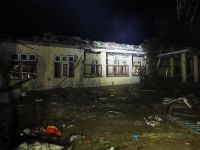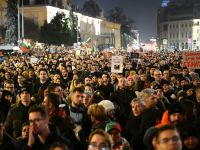Many Lebanese artists have tackled the violence and horror of the country’s Civil War in their work. Few approach it with the uncompromising brutality of Jean Marc Nahas.
The Lebanese painter and draftsman has been exhibiting regularly since 1987 and claims to eschew traditional galleries. Currently exhibiting at Beirut Exhibition Center, one of Beirut’s larger and more mainstream spaces, he seems to be compensating for this lapse in his usual policy by steering well clear of traditional modes of exhibition.
Nahas has divided the enormous venue by creating a loose network of connecting rooms in the middle of the hall. Works completed over the last three years are mounted on these central walls. He’s covered the exterior walls with sheets of thick paper, 2 1⁄2 meters high and up to 12 meters long and for the last three weeks has been frantically overlaying these enormous media with his signature black-and-white drawings.
The artist prepared the exhibition, entitled “Ha’it Hawa’” (Air Wall) – a pun based on the expression “on air” and his live drawing – in just 15 days.
By Wednesday’s opening night Nahas had already succeeded in obscuring most of the white – covering one wall with scrawled figures and animals and doodled plants, swirls and stars, and another with an enormous painting titled “Tetes d’Otages” (Hostages’ Heads), a tiled expanse of innumerable severed heads in black, white and gray.
The artist will continue to work daily throughout the exhibition, which is up until June 2. Visitors are encouraged to stand and watch, turning the show into an unusual blend of performance and fine art.
“I thought the space would be too big,” the artist says, “but in fact it will be too small. I am amazed at how I have managed to fill the space, but I had an impossible amount of adrenalin. I was like a mad thing, like a ball of energy. ... My dream is to paint the Great Wall of China.”
It is not hard to see how Nahas has succeeded in covering the walls in such a short time. Holding a thick black felt-tip in his hand, he draws without pause and seemingly without thought.
He outlines a head on a small blank section of the vast paper that covers the south wall, affixes a long snout, lines its mouth with small pointed teeth and a large, round eye. Regarding the figure for a few seconds, he adds a second pen line, making the eye appear darker and deeper set.
This creature – a motif in the show’s works, whether completed in the past three weeks or the last three years – is a dog, Nahas says. It appears in a different incarnation each time, its head sometimes squat and pig-like, other times closer to the lethal, reptilian snout of an alligator.
“The dog is a way of exercising an illness I have,” Nahas explains. “I am not somebody very normal. I think that’s clear, isn’t it?
“It’s a totem of control,” he continues, “to stop me doing what I condemn in others, such as hitting a child or responding to an insult. The dog is for when I lose control ... but it is like everything in my work ... everything is universal. The veiled woman could be Syrian, Palestinian, Lebanese. ... The dog could be a friend, just as he could be something utterly monstrous.”
Nahas’ comic-book style is reminiscent of French artist Enki Bilal, accentuated by his tendency to work in frames, though the tableaux don’t form a linear narrative. His distinctive cartoon-like drawings are instantly recognizable to those acquainted with his work, as is his macabre subject matter.
There are no surprises here.
Naked women are tied up, sniffed, probed and poked by sharp-toothed, eerily human dogs. These representations of the baser human instincts, and the artist’s own dark, animalistic side, employ sex as a tool of subjugation, humiliation and torture – all recurring themes of Nahas’ darkly beautiful work.
One chaotic jumble of misery, triumph, pain and pleasure – made up of 36 sheets of B2 paper, each one covered with a different black-and-white ink drawing – is simply entitled “Daraa.” The Syrian town, now famous as the site of the protests that sparked Syria’s Civil War, draws Nahas because of its association with violence.
In one drawing three middle-aged veiled women cower in fear amid a tangle of thorny vines or barbed wire, face-to-face with three rabid looking dogs, maws grimacing aggressively.
Other scenes capture an old woman lying prone, two knives protruding from her ample torso. Two dogs look on with expressions that mirror her own: a mixture of pain and horror.
In a third scene a rotund blonde lies naked on her front, while a large bald man in patterned shorts mounts her, an arrow protruding from his round buttocks, a grotesque parody of Cupid’s arrow piercing a heart with love.
In spite of his preoccupation with death and the subjugation of women – depicted either veiled and under attack or naked and spread-eagled, often engaged in submissive sexual acts – Nahas is at times capable of a whimsical, almost tender approach to his subjects.
“I speak about misery everywhere, Syria, Palestine – everywhere,” he says. “For me if there is evil then it concerns me. ... A woman who is violated is a woman who is violated. It’s the same suffering whether it’s my mother or any other woman.
“I speak about me,” he continues, “I speak about my emotions. I speak of my pain, my anguish. Of course you see war, you see women. ... I tell the story of Jean Marc Nahas. I don’t want to enter into other discourse; I don’t want to save humanity.
“I am very nihilistic and pessimistic, I think that humanity is beyond saving – it’s f**ked.”
Nahas’ show is not for everyone. Graphic, disturbing and uncompromising, it may offend more conservative viewers. Those unconcerned by scenes of violence, however, will find the artist’s work is imbued with the tainted, gothic beauty of a dying rose or a dead bird, compelling the viewer to locate the exquisite within the repugnant.
Jean Marc Nahas’ “Ha’it Hawa’” (Air Wall) is on show at the Beirut Exhibition Center until June 2. For more information see www.beirutexhibitioncenter.com or call 01-962-000 ext. 2883.
By India Stoughton
Does Nahas' live work sound interesting to you or just a little too graphic? Please share with us your thoughts.








